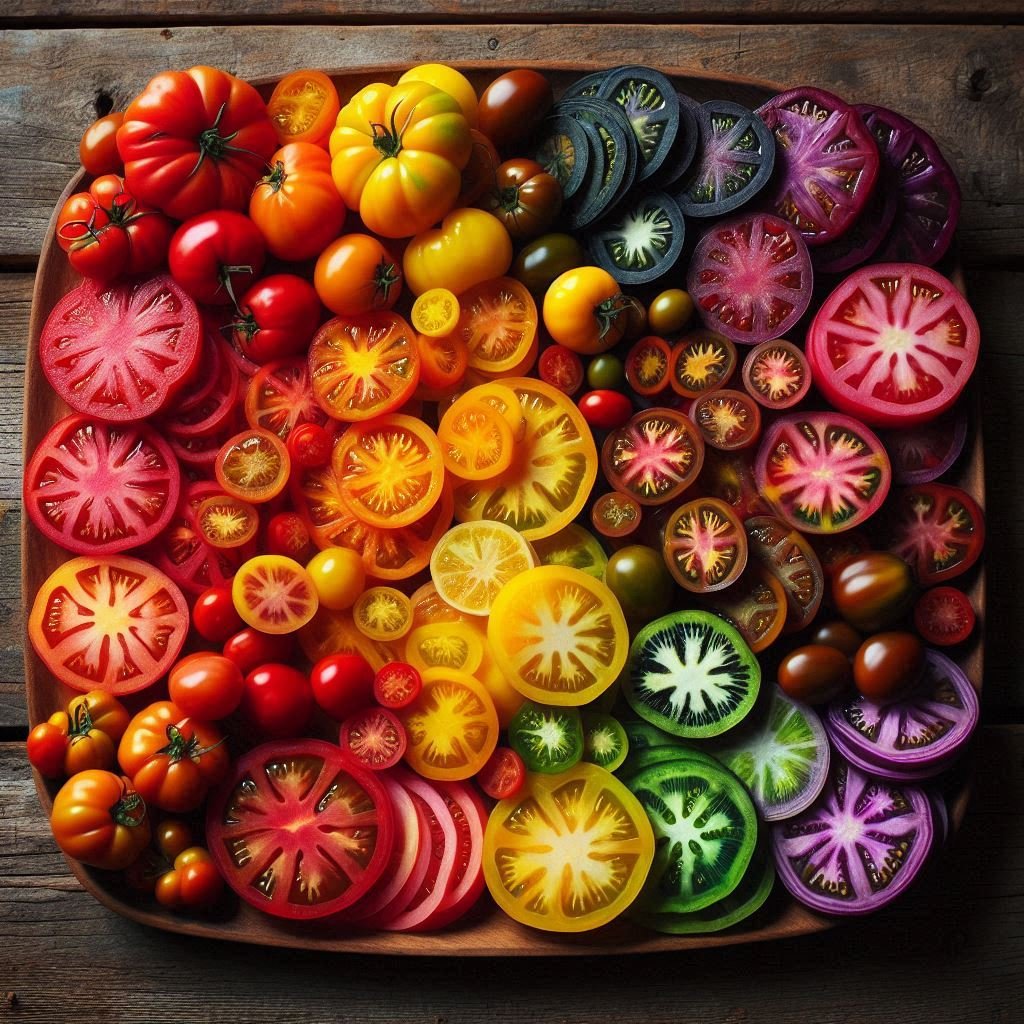is tomato a fruit or vegetable? Unraveling the Culinary Botanical Conundrum
1. The Great Tomato Debate
(is tomato a fruit or vegetable): You’re standing in your cozy kitchen, apron on, ready to whip up something delicious. Your eyes fall on a plump, red tomato sitting on the countertop. But wait—before you decide whether it belongs in a salad or a sauce, let’s unravel the age-old mystery: Are tomatoes fruits or vegetables?
The Botanical Truth: (is tomato a fruit or vegetable)
Let’s get scientific! Botanically speaking, tomatoes are bona fide fruits. Yes, you read that right. They emerge from flowering plants, just like apples, peaches, and strawberries. But here’s the twist: Unlike sweet fruits, tomatoes don’t always scream “dessert.” Instead, they strut their stuff in savory dishes.
Floral Origins and Seed-Containing Goodness
Imagine a tomato plant in full bloom. Those lovely yellow flowers hold the promise of future tomatoes. As these flowers wither away, tiny green orbs appear—the baby tomatoes. Inside each tomato, you’ll find seeds nestled within the juicy flesh. That’s the botanical proof: seeds + ovaries = fruit.
Fun Fact: All True Fruits Come from Flowers (is tomato a fruit or vegetable)
Next time you slice a tomato, remember this: Every true fruit—whether it’s a peach, a grape, or a tomato—starts as a flower’s lovechild. So, when you toss tomatoes into your salad, you’re basically sprinkling floral magic on your greens.

Tomatoes in the Kitchen: Culinary Versatility
When it comes to tomatoes, the kitchen is their playground. These vibrant red orbs are like the Swiss Army knives of ingredients—versatile, dependable, and ready to elevate any dish. So, why do we treat them as veggies? Let’s slice through the culinary layers and find out.
1. The Savory Stars :(is tomato a fruit or vegetable)
Tomatoes: The Unsung Heroes of Salsas and Sauces
Imagine a zesty salsa—diced tomatoes, onions, cilantro, and a hint of lime. It’s the life of the party, whether scooped up with tortilla chips or spooned over grilled chicken. And those rich pasta sauces? Tomatoes are the secret behind that comforting marinara or bolognese. They simmer down, releasing their sweet-tart essence, infusing every bite with flavor.
Pizza and Pasta: Tomato’s Double Act
Let’s talk pizza. That crispy crust, gooey cheese, and—bam!—a tomato sauce base. Whether you’re a Margherita purist or a pepperoni lover, tomatoes play the lead role. And pasta? Well, it owes its saucy existence to these crimson gems. Spaghetti marinara, penne arrabbiata, or lasagna—all bow to the tomato’s culinary prowess.

Tomatoes: The Supreme Court Ruling
1893 Verdict: When Tomatoes Took the Stand (is tomato a fruit or vegetable)
Imagine a courtroom—the air thick with anticipation, legal minds poised for battle. In the red corner (quite literally), we have the tomato. In the green corner (symbolically, of course), we have the United States Supreme Court. The question? Whether tomatoes should be taxed as fruits or vegetables.
The Financial Stakes: Vegetable Taxation
Why the fuss? Well, it all boiled down to money. Back then, imported vegetables faced a tariff, while fruits enjoyed a sweeter deal (pun intended). Tomatoes, being the chameleons they are, straddled both categories. But the court had to pick a side. The stakes were high—revenue for the government and livelihoods for farmers hung in the balance.
Cultural Impact: Shaping Perceptions
And the gavel came down: Tomatoes, you’re veggies! The court ruled that their culinary usage—think savory dishes—outweighed their botanical lineage. But this verdict echoed beyond tax forms. It shaped how we perceive tomatoes. Suddenly, they weren’t just juicy fruits; they were kitchen workhorses, simmering in stews and gracing our pizzas.

Historical Context: The Supreme Court Ruling:
1893 Verdict: Tomatoes on Trial (is tomato a fruit or vegetable)
Imagine a courtroom adorned with mahogany panels, legal minds huddled in debate. The year was 1893, and the United States Supreme Court faced an unexpected case—one that would forever impact our culinary lexicon. The star of the show? The humble tomato.
The Taxing Dilemma
Why did the Supreme Court care about tomatoes? It wasn’t a sudden love for gardening. No, it was about money—specifically, vegetable taxation. You see, vegetables were taxed differently from fruits. And tomatoes, with their dual identity, straddled the line.
Botanical vs. Culinary
Botanically, tomatoes are fruits. Their seeds reside within ovaries, a hallmark of true fruits. But in the kitchen, they play savory roles—sauces, stews, and salads. The court had to decide: Was it the botanical truth or the culinary tradition that mattered?
The Verdict
In a 7-1 decision, the court ruled that tomatoes were vegetables. Why? Because they were commonly used in savory dishes. Justice Horace Gray eloquently stated, “Botanically speaking, tomatoes are fruits. But in the common language of the people… they are vegetables.”
Cultural Footprints
This ruling left cultural footprints. Tomatoes became honorary vegetables, gracing our salads and simmering in our sauces. The taxman was satisfied, but the culinary world remained intrigued. And so, tomatoes continue their dual existence—a botanical enigma we embrace.

Tomatoes: Nutritional Powerhouses:
1. The Basics: Tomato Nutrition Facts
Tomatoes are like nature’s hydrating gift—about 95% water. The remaining 5%? Well, that’s where the magic happens. Here’s a snapshot of what you’ll find in a small (100-gram) raw tomato:
Calories: A mere 18 calories. Yep, they’re practically weightless!
Protein: A modest 0.9 grams. Not exactly a protein powerhouse, but hey, every little bit counts.
Carbs: 3.9 grams. Most of these are simple sugars—glucose and fructose—giving tomatoes their natural sweetness.
Fiber: A respectable 1.2 grams. It’s like a gentle broom for your digestive system.
Fat: A minuscule 0.2 grams. Tomatoes are practically fat-free.
2. Vitamins and Minerals: The Good Stuff
– Vitamin C: The Immune Booster
One medium-sized tomato delivers about 28% of your daily vitamin C needs. It’s like a zesty shield for your immune system.
– Potassium: The Heart’s Best Friend
Tomatoes are rich in potassium, which helps keep your blood pressure in check and your heart happy.
– Vitamin K1: For Clotting and Strong Bones
Vitamin K1 (phylloquinone) hangs out in tomatoes, ensuring your blood clots when it should and your bones stay sturdy.
– Folate (Vitamin B9): Tissue Growth and Cell Function
Especially crucial for pregnant folks, folate keeps tissues growing and cells doing their thing.
3. The Antioxidant All-Star: Lycopene
Lycopene—the red superhero of tomatoes—deserves a standing ovation. It’s an antioxidant that flexes its muscles against free radicals. What does that mean for you? Reduced risk of heart disease and cancer. Plus, it gives tomatoes their vibrant hue.

Seedless Tomatoes: A Marvel of Modern Agriculture
1. The Seedless Revolution(is tomato a fruit or vegetable)
Imagine biting into a tomato without encountering those pesky seeds. It’s like a culinary magic trick! Seedless tomatoes, my friend, are the stars of this show. But how did we achieve this botanical wizardry?
2. The Science Behind It
– Selective Breeding: The Tomato Whisperers
- Plant breeders worked their magic, selecting tomatoes with fewer seeds. Generation after generation, they nudged the genetics toward seedlessness.
- Imagine them huddled in greenhouses, whispering, “Grow, little tomato, grow—without seeds!”
– Triploidy: The Chromosomal Twist
- Seedlessness often involves playing with chromosomes. Triploid tomatoes have an extra set of chromosomes, disrupting seed formation.
- It’s like giving tomatoes a bonus genetic puzzle piece.
3. Culinary Perks
– Smooth Sauces and Salsas
- Seedless tomatoes mean smoother sauces. No more fishing out seeds mid-stir!
- Imagine a velvety marinara or a zesty salsa—seedless perfection.
– Juicy Bliss
Bite into a seedless tomato, and you’re greeted by pure juiciness. It’s like summer in every bite.
Slice them for salads, layer them in sandwiches—your taste buds will thank you.

Cultural Lens: Tomatoes Around the World
1. Mediterranean Love Affair
Close your eyes and imagine sun-kissed terraces overlooking azure seas. That’s the Mediterranean—a region where tomatoes are revered. Here’s how they steal the spotlight:
– Greek Salads (Horiatiki)
- Picture a rustic wooden table, olives scattered like confetti, and a vibrant Greek salad at the center. Tomatoes—ripe, juicy, and sprinkled with feta—add a burst of color. 🇬🇷
– Italian Caprese
- Ah, Italy—the birthplace of romance and pizza. Caprese salad celebrates simplicity: tomatoes, mozzarella, basil, and a drizzle of olive oil. It’s like a flavor symphony. 🇮🇹
2. Global Tomato Tango
– Indian Curries
- In India, tomatoes shimmy into curries, lending their tangy sweetness. Imagine a rich tomato-based tikka masala or a fiery vindaloo. 🇮🇳
– Mexican Salsas
Mexico knows how to salsa! Tomatoes, jalapeños, onions—they dance together in vibrant harmony. Scoop it up with tortilla chips, and you’re in fiesta mode. 🇲🇽

Seedless Tomatoes: The Marvels of Modern Agriculture
1. The Seedless Wonder
Imagine a tomato without those tiny, pesky seeds—no more spitting them out or meticulously scooping them from your sandwich. Seedless tomatoes are the rock stars of convenience. But how did we achieve this botanical magic?
2. The Science Behind It (is tomato a fruit or vegetable)
The Genetic Dance
Seedlessness isn’t a random mutation—it’s a carefully orchestrated genetic ballet. Plant breeders selectively cross tomato varieties, aiming for the perfect blend of traits. They want juicy, flavorful fruits minus the seed baggage.
3. The Culinary Perks
Smooth Sauces and Uninterrupted Bites
Seedless tomatoes elevate our kitchen adventures. Imagine whipping up a marinara sauce without sieving out seeds or enjoying a caprese salad with uninterrupted tomato slices. These beauties are like the VIP section of the tomato world.

6. Culinary Creativity
Beyond Salads
Seedless tomatoes aren’t just salad stars. They shine in sandwiches, wraps, and even as pizza toppings. Their versatility knows no bounds. Plus, they’re a hit with kids—no seed-spitting contests required.
7. The Future of Tomatoes
Breeding Breakthroughs
Plant scientists continue their tomato tango. What’s next? Perhaps tomatoes that whisper recipe ideas or ones that self-slice (okay, maybe not). But seriously, expect more flavor, color, and convenience.

Heirloom Tomatoes: A Flavorful Journey Through Time
1. The Heirloom Legacy
Imagine stepping into a sun-kissed garden, surrounded by tomato vines that whisper tales of generations past. These are heirloom tomatoes—the keepers of flavor, color, and history.
2. What Makes Them Heirloom?
The Heritage Factor
Heirlooms aren’t just tomatoes; they’re living heirlooms. Passed down through families, they carry stories from yesteryears. These aren’t mass-produced hybrids; they’re the rebels—the ones that defy uniformity.
3. A Rainbow of Colors

4. Flavor Explosion
Taste the Difference
Close your eyes and take a bite. Heirlooms burst with flavor—sweet, tangy, earthy. They’re the jazz musicians of tomatoes, riffing on taste notes. Forget blandness; embrace complexity.
5. Shapes and Sizes

6. The Garden-to-Table Connection (is tomato a fruit or vegetable)
Local Love:
Heirlooms thrive in backyard gardens and farmers’ markets. They’re the essence of farm-to-table dining. Imagine a chef slicing an heirloom, its juices mingling with fresh basil. That’s culinary poetry

For more health related knowledge visit the home page.
And for more explanation visit this article.


